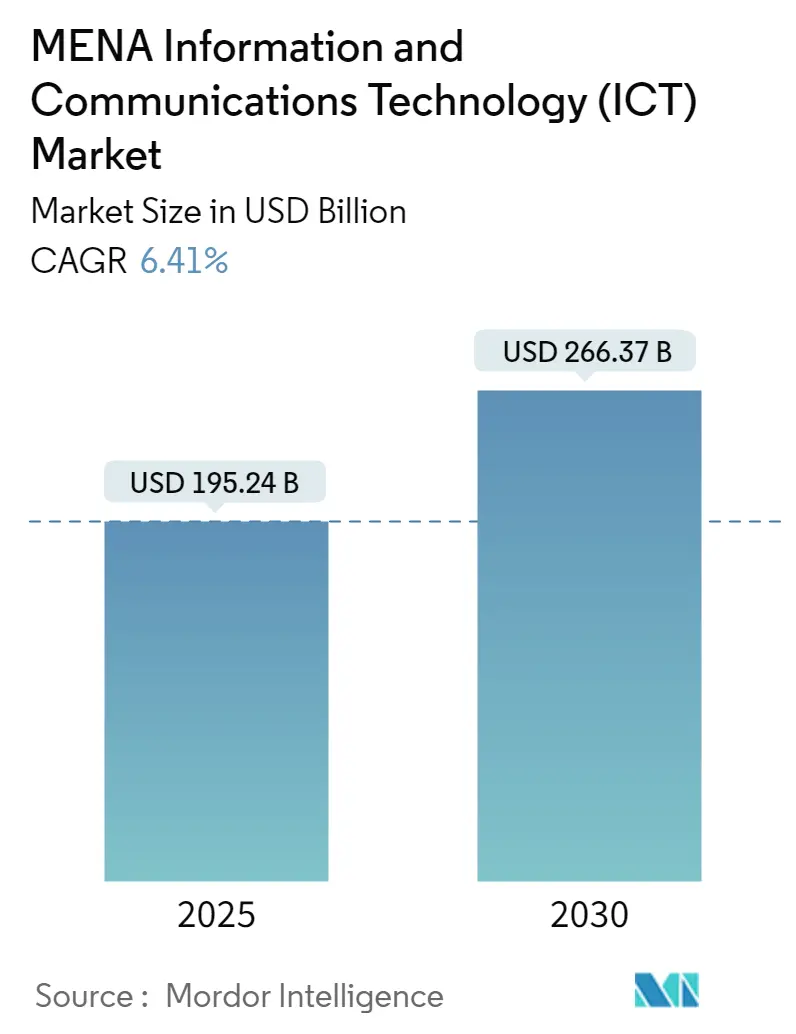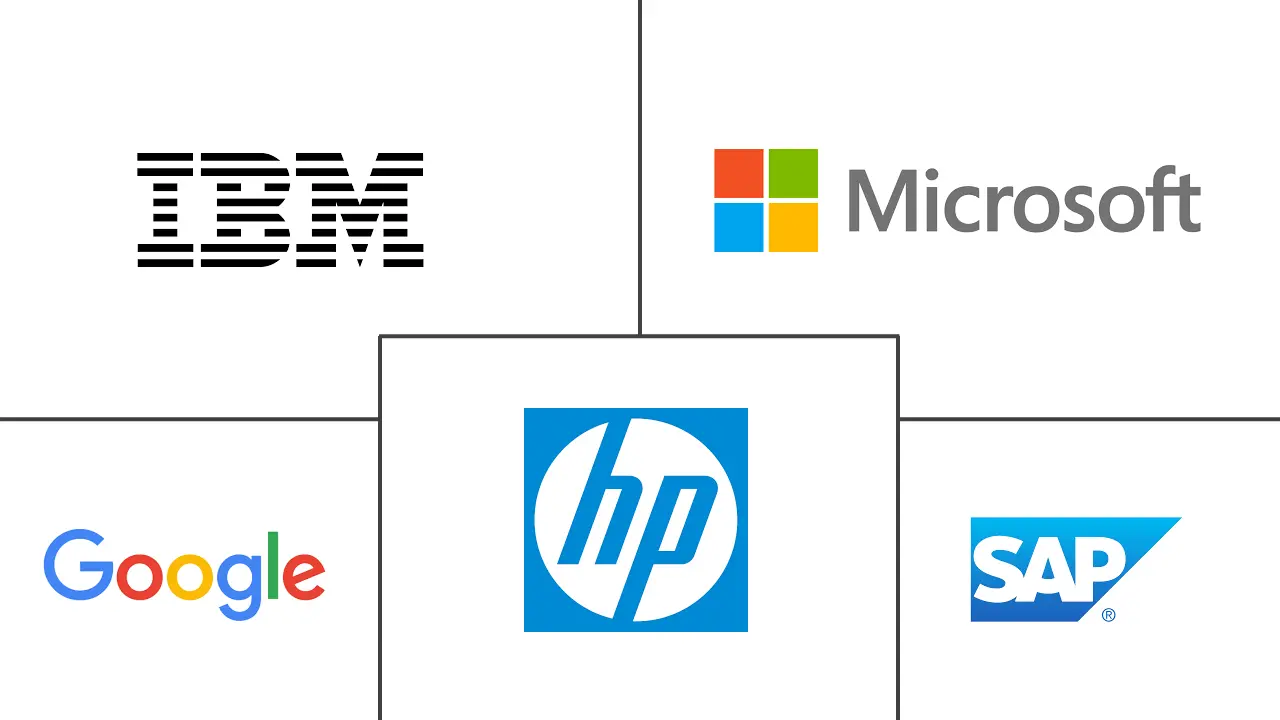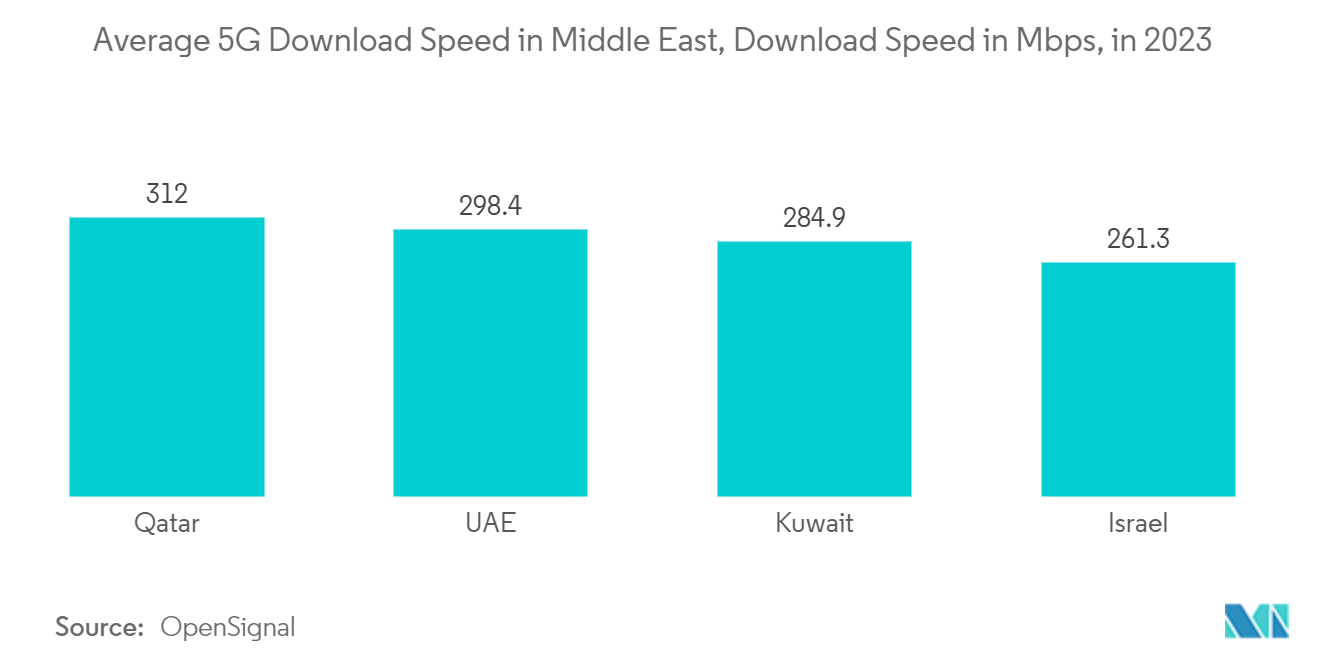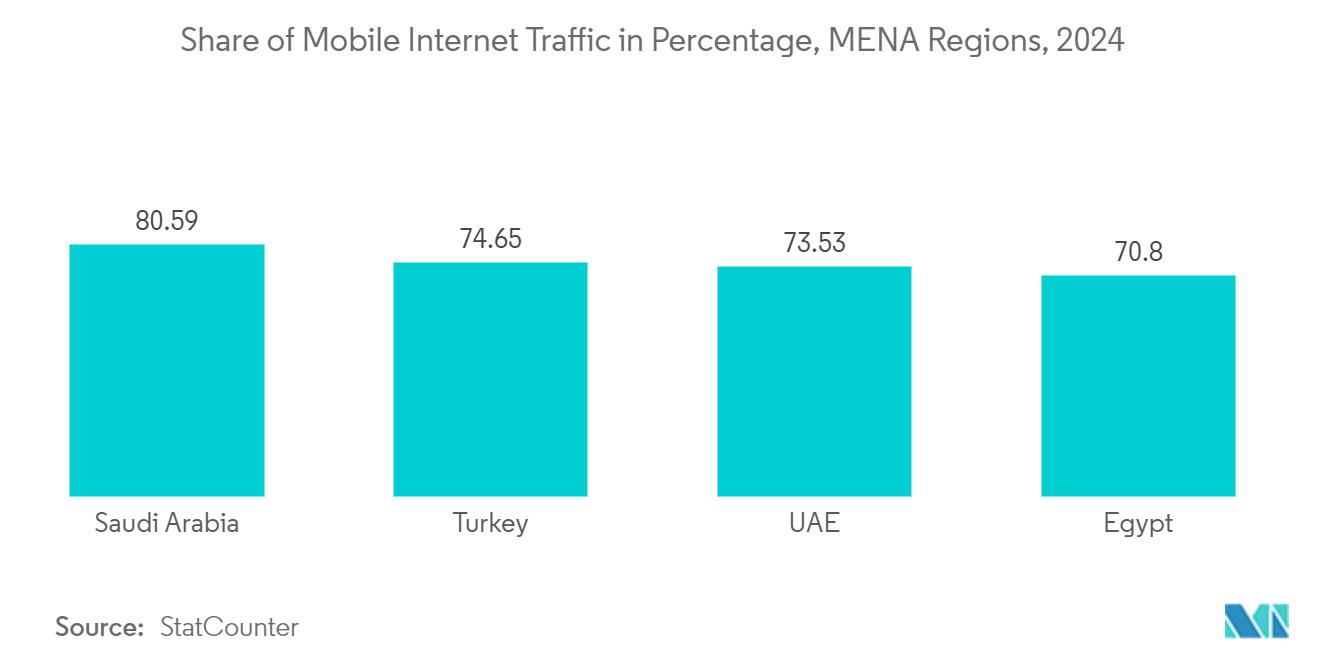
| Study Period | 2019 - 2030 |
| Base Year For Estimation | 2024 |
| Forecast Data Period | 2025 - 2030 |
| Market Size (2025) | USD 195.24 Billion |
| Market Size (2030) | USD 266.37 Billion |
| CAGR (2025 - 2030) | 6.41 % |
| Market Concentration | High |
Major Players
*Disclaimer: Major Players sorted in no particular order |
MENA Information and Communications Technology (ICT) Market Analysis
The MENA Information and Communications Technology Market size is estimated at USD 195.24 billion in 2025, and is expected to reach USD 266.37 billion by 2030, at a CAGR of 6.41% during the forecast period (2025-2030).
- Ongoing Events and Tourism Driving Automation: The MENA ICT market is witnessing a surge in automation demand, catalyzed by ongoing events and tourism. In 2022, the UAE's travel and tourism sector contributed AED 167 billion to the GDP, representing 9% of the total. International tourists spent AED 117.6 billion, with hotel capacity expanding to 203,000 rooms across 1,189 establishments. This rise in tourism is driving the adoption of smart technologies:
- Automated check-ins: Self-service kiosks streamline guest experiences in hotels and airports.
- Smart room controls: Enhance comfort while improving energy efficiency through IoT devices.
- Baggage automation: Airports are implementing automated baggage handling systems for operational efficiency.
- Tourist attractions: Automated ticketing and guided tours are becoming standard, improving visitor management.
- Government Policies Fostering Digital Transformation: Government strategies across the MENA region are pivotal in driving digital transformation. These initiatives aim to diversify economies and bolster ICT infrastructure:
- UAE Digital Government Strategy 2025: Promotes governance that is digital-by-design, integrating technology across government functions.
- Egypt Vision 2030 and Digital Egypt: Focus on infrastructure development, innovation, and fostering digital skills to fuel economic growth.
- Oman’s Digital Transformation Program: Targets sustainable knowledge building and enhancing public sector productivity by upgrading digital infrastructure.
- Saudi Arabia’s Vision 2030: Emphasizes 5G deployment, e-government, data governance, and cybersecurity, setting a foundation for nationwide digital progress.
- Rising Digital Transformation Across Industries: The MENA region is experiencing substantial digital transformation across sectors, with industries increasingly integrating cutting-edge technologies:
- Healthcare: Providers like Medeor Hospitals and Mediclinic are adopting unified healthcare information systems to improve patient engagement.
- Financial sector: Fintech solutions, including digital banking and payment systems, are seeing widespread adoption.
- Manufacturing: Industry 4.0 technologies, such as AI-driven predictive maintenance, are being implemented to enhance operational efficiency.
- Retail: Big data analytics is being used to personalize customer experiences and optimize inventory management.
- Regulatory Reforms Shaping the ICT Landscape: Regulatory frameworks are crucial in creating a competitive ICT environment. Key focus areas include:
- Licensing frameworks: Balancing industry growth with regulatory control for sustainable development.
- Spectrum allocation: Ensuring adequate bandwidth for expanding telecommunication needs.
- Data protection laws: The UAE’s 2021 federal law on personal data protection sets new standards for safeguarding user data.
- Cybersecurity regulations: Information Assurance Regulations are in place to protect the region’s critical digital infrastructure.
- Investment and Partnerships Driving Innovation: Significant investments and partnerships are accelerating digital transformation in the MENA ICT sector:
- Mindware and Xebia (Nov 2023): This partnership will enhance digital transformation across the Middle East & Africa by leveraging Xebia’s AI and cloud expertise.
- Saudi investments: Over $9 billion has been allocated to digital transformation projects, reinforcing Saudi Arabia’s commitment to tech infrastructure.
- Memory Technology Middle East and Huawei (Jul 2023): Partnering to boost digital services for UAE-based SMBs.
- KT, Hyundai E&C, and STC Group: A joint initiative to establish digital infrastructure in Saudi Arabia, including internet data centers and smart cities.
- Market Growth and Future Outlook: The MENA ICT market is on a trajectory of substantial growth. Egypt’s ICT market alone, valued at $14.65 billion in 2022, is expected to reach $27.52 billion by 2028, growing at a CAGR of 10.58%. Major drivers include:
- Smartphone penetration: Expected to hit 92% by 2030, bolstering demand for ICT services.
- Government initiatives: Digital transformation efforts across sectors will fuel industry growth.
- 5G and IoT expansion: Increased demand for cloud computing and data center services will underpin ICT market expansion.
MENA Information and Communications Technology (ICT) Market Trends
Mobility and Telecom Largest Technology Segment
The Mobility and Telecom sector held the largest share of the MENA ICT market in 2022, valued at USD 25.55 billion. The sector is expected to reach USD 35.69 billion by 2029, growing at a CAGR of 4.89%. This underscores the critical role telecommunications plays in the region’s digital landscape.
- 5G expansion: The UAE was the first in the MEA region and fourth globally to launch a 5G network. Leading telecom operators Du and Etisalat have been at the forefront of 5G development, which will boost demand for advanced mobile services.
- Infrastructure upgrades: Oman plans to phase out its 3G networks by 2024, a move that will necessitate significant telecom infrastructure investments.
- Cybersecurity concerns: Increasing reliance on mobile technologies has led to a rise in cyberattacks, intensifying the need for robust security solutions within the telecom sector.

Egypt Fastest Growing Regional Segment
Egypt’s ICT market is expanding rapidly, with its value projected to rise from USD 14.65 billion in 2022 to USD 27.52 billion by 2028. This growth reflects Egypt’s prominent role in regional digital transformation efforts.
- Government-led initiatives: Egypt’s ICT 2030 strategy focuses on infrastructure development, technology parks, and building digital capacities, driving the ICT sector’s expansion.
- Digital Egypt vision: The Digital Egypt initiative is transforming the public sector by digitizing services and creating a data-driven governance ecosystem.
- Strategic partnerships: Telecom Egypt’s collaboration with ICANN to introduce the Managed Root Server in the country reflects ongoing efforts to enhance internet flexibility and reduce reliance on external networks.

MENA Information and Communications Technology (ICT) Market Overview
Global Giants Lead in a Consolidated Market: The MENA ICT market is consolidated, with global tech conglomerates such as Google, IBM, Microsoft, SAP, Oracle, and AWS holding significant market shares. These companies leverage their resources and expertise to provide comprehensive ICT solutions across sectors.
Strategic partnerships: Mindware’s collaboration with Xebia (Nov 2023) exemplifies the type of strategic alliances that drive digital transformation.
Innovation leadership: UAE-based G42 launched a $10 billion expansion fund in 2022, focusing on transformative technologies like AI and cloud computing, underscoring the region’s commitment to digital innovation.
Strategies for Future Success: To succeed in the MENA ICT market, companies must focus on several key strategies:
Investing in local partnerships: As seen with KT and STC Group, developing local infrastructure is critical for long-term growth.
Emerging technologies: Prioritizing technologies such as 5G, IoT, and fintech solutions is crucial, with Saudi Arabia’s fintech sector expected to see significant growth.
Regulatory alignment: Aligning with government initiatives like Egypt’s ICT 2030 strategy can open doors for extensive opportunities.
Skills development: Training and capacity building, exemplified by the UAE’s ICT Fund, will be pivotal in addressing the skills gap in the tech workforce.
MENA Information and Communications Technology (ICT) Market Leaders
-
Google LLC (Alphabet Inc.)
-
IBM Corporation
-
Microsoft Corporation
-
HP Inc.
-
SAP SE
- *Disclaimer: Major Players sorted in no particular order
-ICT-Market-competive-loog.webp)
MENA Information and Communications Technology (ICT) Market News
- November 2023 - Mindware partnered with Xebia to advance digital transformation initiatives in the Middle East & Africa by combining distribution with cloud and AI expertise.
- October 2023 - KT, Hyundai E&C, and STC Group formed a long-term partnership to develop digital infrastructure in Saudi Arabia, focusing on smart cities and data centers.
MENA Information and Communications Technology (ICT) Market Industry Segmentation
The MENA ICT market includes the amalgamation and adoption of different Information and Communications Technologies (ICT), such as big data, mobility, storage, outsourcing, and cloud computing in MENA for the purpose of digitization and digital transformation. It tracks the revenue accrued through the sale of technology-related solutions.
The MENA ICT market is segmented by technology (big data analytics, mobility and telecom, cloud computing, storage, business process, and outsourcing), component (hardware/devices, software and services, and communication and connectivity), end-user industry (oil, gas and utilities, travel and hospitality, healthcare, financial services, and manufacturing and construction), and country (Saudi Arabia, United Arab Emirates, Qatar, Oman, Egypt, and Rest of MENA). The market sizes and forecasts are provided in terms of value (USD) for all the above segments.
| By Technology | Big Data Analytics |
| Mobility and Telecom | |
| Cloud Computing | |
| Storage | |
| Business Process Outsourcing | |
| Other Technologies | |
| By Component | Hardware/Devices |
| Software and Services | |
| Communication and Connectivity | |
| By End-user Industry | Oil, Gas and Utilities |
| Travel and Hospitality | |
| Healthcare | |
| Financial Services | |
| Manufacturing and Construction | |
| Other End-user Industries | |
| By Country | Saudi Arabia |
| United Arab Emirates | |
| Qatar | |
| Oman | |
| Egypt | |
| Rest of MENA |
MENA Information and Communications Technology (ICT) Market Research FAQs
How big is the MENA ICT Market?
The MENA ICT Market size is expected to reach USD 195.24 billion in 2025 and grow at a CAGR of 6.41% to reach USD 266.37 billion by 2030.
What is the current MENA ICT Market size?
In 2025, the MENA ICT Market size is expected to reach USD 195.24 billion.
Who are the key players in MENA ICT Market?
Google LLC (Alphabet Inc.), IBM Corporation, Microsoft Corporation, HP Inc. and SAP SE are the major companies operating in the MENA ICT Market.
What years does this MENA ICT Market cover, and what was the market size in 2024?
In 2024, the MENA ICT Market size was estimated at USD 182.73 billion. The report covers the MENA ICT Market historical market size for years: 2019, 2020, 2021, 2022, 2023 and 2024. The report also forecasts the MENA ICT Market size for years: 2025, 2026, 2027, 2028, 2029 and 2030.
Our Best Selling Reports
MENA Information and Communications Technology (ICT) Market Industry Report
MENA ICT Market Research
Our MENA ICT market research report provides comprehensive industry analysis, covering the latest trends in digital transformation, technology adoption, and investment across the Middle East and North Africa. The report delves into the region’s key sectors, including telecom, cloud computing, and cybersecurity, highlighting growth drivers such as 5G network expansion, government initiatives, and strategic partnerships. With detailed industry information and market segmentation, the report is designed to equip stakeholders with actionable insights to navigate the rapidly evolving landscape.
All key findings are available in an easy-to-read report pdf format, enabling stakeholders to access market data, industry trends, and investment forecasts effortlessly. By leveraging our in-depth analysis, businesses can capitalize on emerging opportunities in the ICT infrastructure, software development, and data center markets, positioning themselves for sustained success in this dynamic region.




